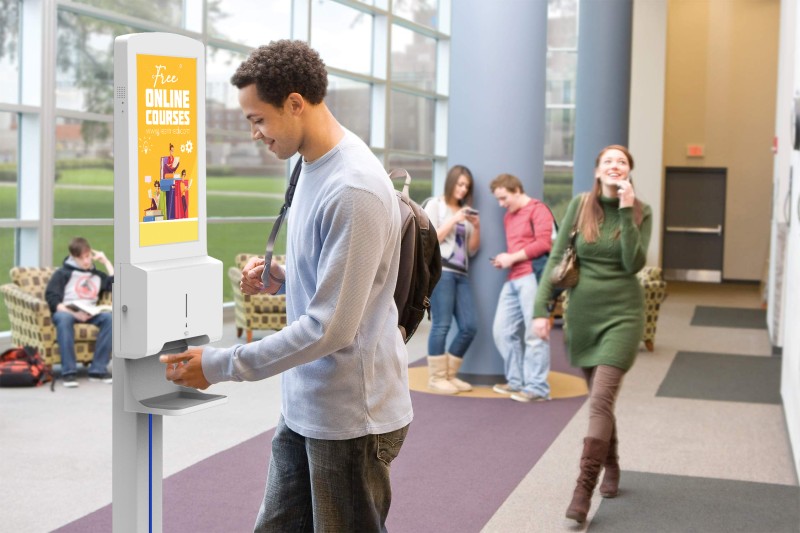
How COVID-19 Has Shaped Digital Signage Trends
July 29, 2020 by Dave Haynes
Guest Post: Chloe Weaver, Allsee Technologies
Towards the end of February, just as the number of countries with confirmed cases of coronavirus began to surge, I was researching key trends in the digital signage industry for 2020.
Many reports predicted increasing affordability due to falling production costs, leading to increased adoption by high street stores to help them compete with online retailers by creating a better in-store experiences. Artificial Intelligence (AI) was predicted to grow in prevalence, for instance using facial recognition to personalize on-screen content depending on who is looking at the display. And of course, it was unanimous that the popularity of touch screens would only continue to rise.
Sure, fears about coronavirus loomed in the back of my mind, but I never imagined it would change the face of the digital signage industry so dramatically.
Now, as I write this article in July, nobody could have predicted the direction the industry has taken. Many companies have adapted astonishingly quickly, launching new products to tackle problems caused by the pandemic that would have been unheard of just a few short months ago. I mean, who would have believed that hand sanitizer dispensers combined with digital displays would become the must-have product of 2020?
Yet that’s exactly the situation we find ourselves in. So far, we’ve seen more demand for this solution than any other, with units selling faster than we can stock them. Our network of distribution partners report that businesses across all different industry sectors, from golf clubs to supermarkets to offices, are utilizing these hand sanitizer displays to deliver messages whilst people sanitize their hands.
Despite their popularity, we’ve also had feedback that some end users are concerned about investing in a solution that they fear will only have a relatively short lifespan.
But what do the experts think?
We asked a panel of digital signage specialists, many of whom have decades of industry experience, how long they thought these hand sanitiser displays would retain their usefulness. They agreed that even if government measures such as lockdowns, self-isolating and social distancing are successful in flattening the first peak, coronavirus will still be a prevalent issue until a vaccine is developed, tested and approved for mass use. As this isn’t likely to happen before mid-2021 at best, these displays should have at least another year or so of popularity.
On top of this, after 18 months of people habitually washing their hands upon entering and leaving a building, our specialists predict that this behaviour will become ingrained into our routines. Even after the main threat has passed, the fear of being unclean will take months (if not years) to fade, resulting in long-term demand for hand sanitizer dispensers.
So, it seems that the popularity of hand sanitizer displays is here to stay for the next few years, but how has this pandemic affected the future of the industry on a wider scale?
Linking back to the trends I outlined at the beginning of this article, we could now see a delay in better affordability for end users as digital signage suppliers try to re-coup lost money lost by increasing their pricing. However, one trend that I believe has not changed is increased adoption of digital signage by retail stores. After more and more consumers turned to online shopping during lockdown, the need for brick-and-mortar stores to find new ways draw people back onto the high street has only increased.
As predicted, the incorporation AI and facial recognition into digital signage solutions has become more widespread, but for the new purpose of detecting whether someone is wearing a mask or has a fever. Of course, as with hand sanitizer displays, companies need to think about how they can increase the longevity of this type of product. For instance, by adding functionality that enables the display to be used as a checking in/out system after the mask detection and temperature checking functions have become obsolete.
Finally, and perhaps most surprisingly, touch screens seem to have been knocked off their pedestal. For now, people’s love of interactivity has been outweighed by their fear of touching things in public places, although how long this will last is anyone’s guess.
As we move into the second half of 2020, nobody can say how the situation surrounding the coronavirus pandemic will continue to evolve. But I know that the digital signage industry will evolve with it and I, for one, am intrigued to see what future trends and innovations this tumultuous year will bring next.
About The Writer
Chloe Weaver is a Digital Marketing Executive at Allsee Technologies. During her time within the digital signage and commercial display industry Chloe has gained a wealth of knowledge about marketing strategies within AV. Chloe has been instrumental to the marketing direction of Allsee Technologies during the COVID-19 pandemic. Allsee Technologies were founded in 2007 and have offices, showrooms and warehouse facilities in Birmingham, United Kingdom as well as Oostende, Belgium. Allsee has quickly developed into a market leading digital signage solutions manufacturer with an impressive Blue Chip client portfolio.





Leave a comment